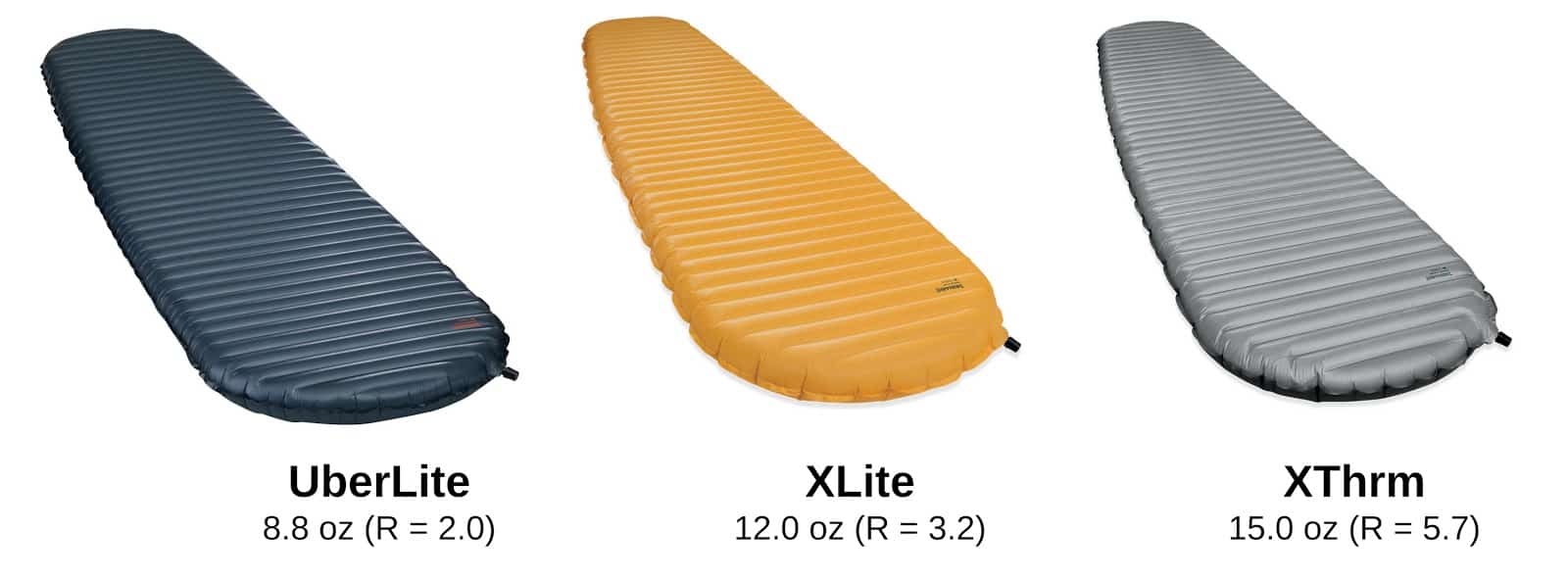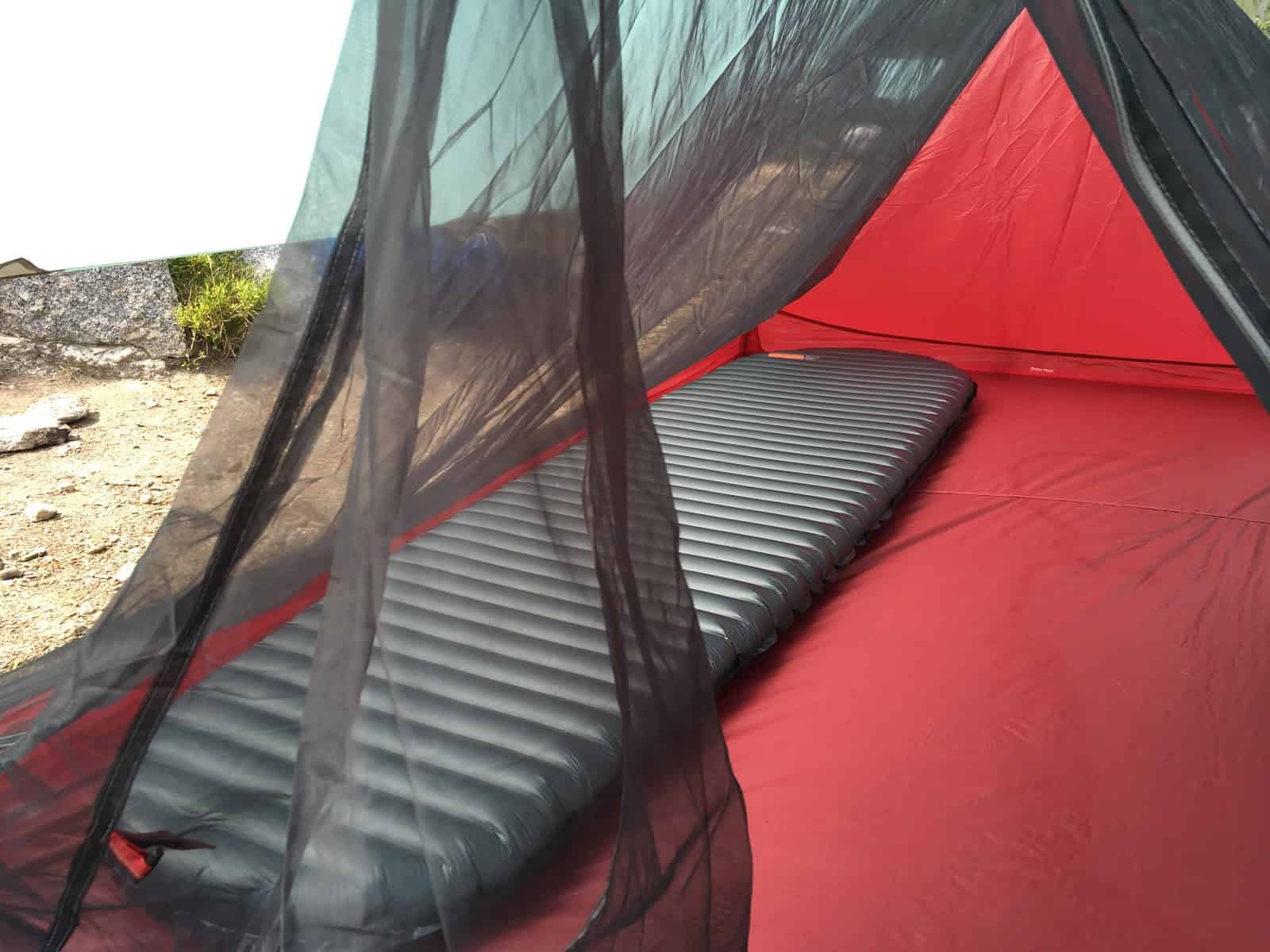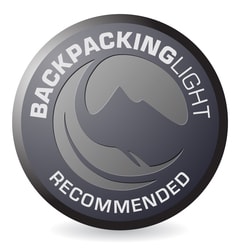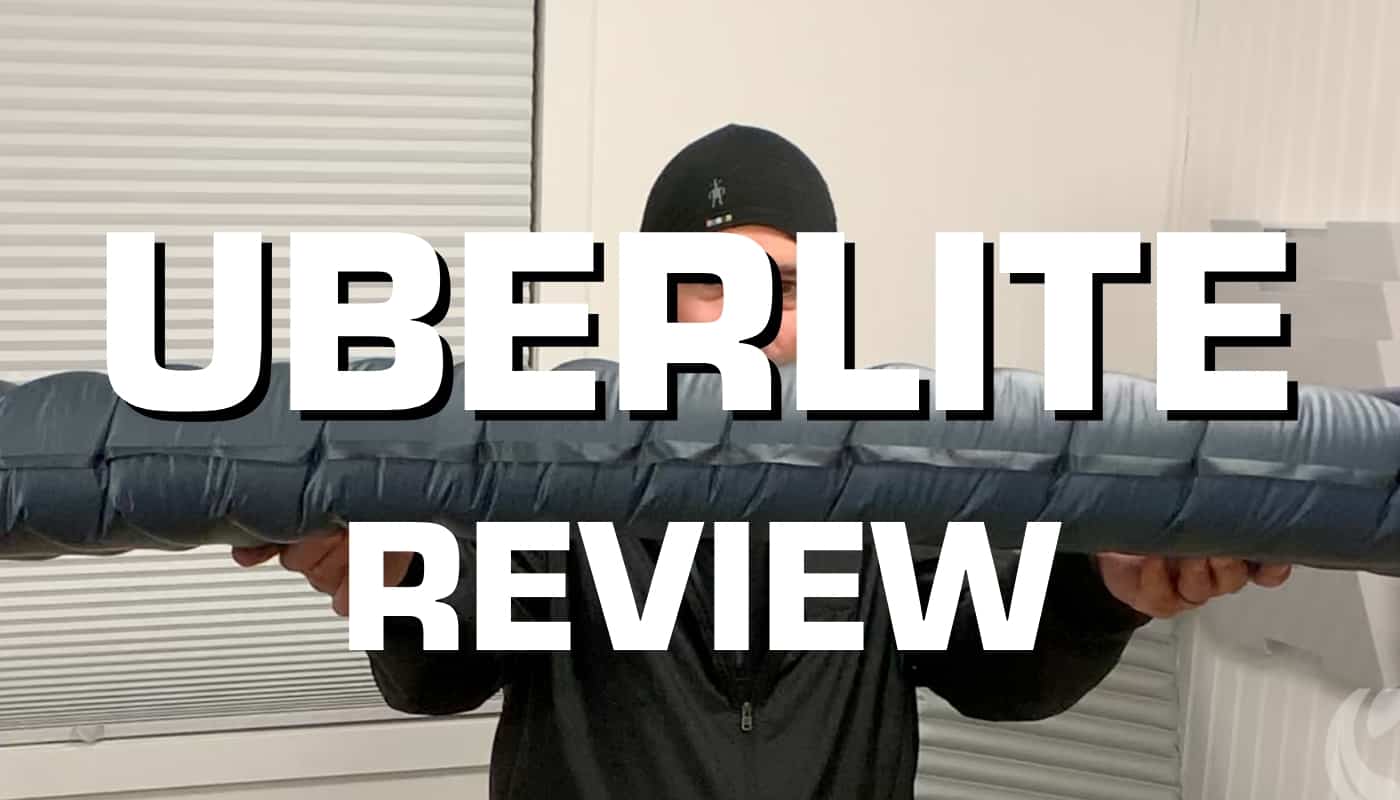Introduction
This Therm-a-Rest NeoAir UberLite review presents our performance assessment of the lightest full-sized air-filled sleeping pad on the market.
The Therm-a-Rest NeoAir UberLite is an 8.8-oz inflatable air mattress (i.e., size "regular" - 20 in wide x 72 in long). Users of the Therm-a-Rest XLite and XTherm will recognize the UberLite’s shape and basic design. The UberLite is a little over three ounces lighter than the XLite. It also packs down smaller and sleeps more quietly. The tradeoff? Warmth.
Here's how the three mummy-shaped pads in the Therm-a-Rest NeoAir line compare:

| UberLite | XLite | XTherm | |
|---|---|---|---|
| Weight | 8.8 oz | 12.0 oz | 15.0 oz |
| Packed Size | 6.0 in x 3.5 in | 9.0 x 4.0 in | 9.0 x 4.0 in |
| Top Fabric | 15 denier ripstop nylon | 30 denier ripstop HT nylon | 30 denier ripstop HT nylon |
| Bottom Fabric | 15 denier nylon | 30 denier ripstop HT nylon | 70 denier nylon |
| R-Value | 2 | 3.2 | 5.7 |
| MSRP | $179.95 | $169.95 | $199.95 |
All specs are for a regular-sized pad (20 in width x 72 in length x 2.5 in thickness). The UberLite is also available in short and long sizes.
In addition to the obvious differences in weight, warmth (R-value), and packed volume, you can see that the Therm-a-Rest NeoAir UberLite is made with lighter fabrics. Therm-a-Rest claims in particular that the UberLite's top fabric is quieter than the fabrics used in the other two pads, a performance feature we'll look at in this review.
Watch Ryan Jordan's video about how he uses the Therm-a-Rest NeoAir UberLite for winter camping, as well as a summary of the findings presented in this review:
https://youtu.be/WclaIw_oxF0Features
- Horizontal Baffles
- Triangular Core Matrix construction
- Quiet top fabric
- Compresses to the size of a beer can
- Stuff sack and repair kit included
- Standard Therm-a-Rest valve system
- MSRP: $179.95 (Pre-order/Purchase from REI)
Specifications
- Weight (regular): 8.8 oz (249 g)
- Measured Weight (mattress only): 7.9 oz (224 g)
- Measured weight including stuff sack and repair kit: 8.3 oz (235 g)
- Width (regular): 20 in (50 cm)
- Length (regular): 72 in (183 cm)
- Thickness: 2.5 in (6.4 cm)
- R-Value: 2.0
- Packed Dimension: (out of the box): 6 in x 3.5 in (15.2 cm x 8.9 cm)
- Top fabric type: 15 denier ripstop nylon
- Bottom fabric type: 15 denier nylon
Review Context

Why choose an inflatable air mattress in the first place?
Closed cell foam pads (generally) insulate better (higher R:thickness ratio), are tough, have multiple uses (e.g., stove windshield, lounge pad on abrasive ground, internal pack frame), are significantly cheaper, and weigh about the same.
For instance, check out the specs for the Therm-a-Rest RidgeRest SOLite. This pad gets you more utility at virtually the same weight as the current gold standard in inflatable mattresses, the Therm-a-Rest NeoAir XLite - for a fraction of the cost.
| NeoAir XLite | RidgeRest SOLite | |
|---|---|---|
| Weight | 12.0 oz | 14.0 oz |
| Packed Size | 9.0 x 4.0 in | 20.0 x 8.0 in |
| Top Fabric | 30 denier ripstop HT nylon | cross-linked polyethylene closed cell foam |
| Bottom Fabric | 30 denier ripstop HT nylon | cross-linked polyethylene closed cell foam |
| R-Value | 3.2 | 2.8 |
| MSRP | $169.95 | $29.95 |
The answer is one word: comfort.
Those who can sleep well on a textured and relatively thick closed cell foam pad are a special breed. Hikers that can wake up feeling rested after a night on a very thin foam pad are even rarer. If your dedication to ultralight backpacking means you are willing to suffer sleepless nights in the pursuit of ounce shaving, you are one tough cookie. But I would argue that sleep deprivation will eventually catch up with you and degrade your hiking performance regardless of how light your pack is. The longer your hike, the more this is likely to come into play.
It is true that most bodies and minds will adapt (somewhat) to sleeping on a thin closed cell foam pad. I thru-hiked the Appalachian Trail and Colorado Trail using a 5/8" closed cell foam pad, and eventually got (sort of) used to sleeping on it. But I never got what I would consider an excellent night’s sleep, and suffered extensively from numb shoulders and achy hips.
So while R-Value, durability, and price are all important considerations for an inflatable mattress, comfort is king, especially if you are the type of person where comfort on a closed cell foam pad is elusive. Or, should I say, the comfort-to-weight-ratio is king. It is the chief factor that separates inflatable air mattresses from other types of pads.
Of course, comfort is subjective, particularly where sleep is involved. If it were easy to objectively quantify comfort we’d all be sleeping like kings every night in the backcountry. I don’t have to tell you this isn’t the case! So you’ll see words like feels and seems pop up from time to time in this review, particularly where comfort is concerned. I can only offer you my subjective opinion here, and provide you with anecdotal data that will allow you to extrapolate what your own experience might be. In all other performance metrics (weight, durability, etc.) I remain as objective as possible.
Description of Field Testing

Therm-a-Rest recommends the UberLite for summer use. Production samples of the mattress were not available until the late summer of 2018, so I was not able to test the UberLite in peak summer conditions. In some ways, that limitation works out nicely. I think that the average user of this mattress will not contain herself to summer conditions but will instead be sleeping on the UberLite across three seasons, depending on conditions. Rare is the backpacker that can afford to own a separate mattress purely for summer temperatures.
I tested the UberLite across the late summer and fall, in three mountain ranges, and at elevations ranging from 5,000 ft to 11,000 ft.
My first wilderness test was a two night trip in the Wind River Range in Wyoming in late summer. Both campsites were 10,000 ft to 11,000 ft. Conditions at night were windy with light-to-heavy rain and temperatures dropping just below freezing. Daytime hikes consisted of steep climbs and high elevation peak bagging, with correspondingly low mileage.
My second test was a six-night off-trail trek through Montana’s Absaroka-Beartooth Wilderness in early fall (story about that trek here). Campsite elevations ranged from 6,000 ft to 10,000 ft. Evening temperatures ranged from the low 20s (deg F) to mid 30s (deg F) with occasional high winds and light rain. Daytime hiking consisted of steep ups and downs over high passes and through dense brush. Long hiking days (up to 12 hours a day) with up to several thousand feet of elevation gain, combined with inclement weather and chilly nights provided a good backdrop for testing an ultralight sleep system and evaluate its ability to help me recover each day.
Finally, I tested the UberLite on several late fall one and two-night excursions in California's Eastern Sierra. Overnight temperatures fell to the 20s and 10s (deg F), with occasional light to moderate snow. Daytime hiking was characterized by high-mileage days through shallow snow.
I’m 5 ft 6 in (168 cm) tall, weigh 160 lb (73 kg), and used a regular sized mattress.
Member's Only Content
Login as a Premium or Unlimited Member to read the comprehensive Performance Assessment and Author Commentary sections of this review:
- Performance Assessment - Comfort, Weight, Compressibility, Durability, Usability, and Finish Quality
- Product Strengths and Limitations
- Compared To - Therm-a-Rest XLite, Sea to Summit Ultralight Mat, Big Agnes Insulated AXL, REI Flash, NEMO Astro Lite, Klymit Inertia X-Frame, Expeditor Airmat HL
- Commentary
Member's only version is 4,400 words and includes 13 photographs.
Review Rating

Recommended
The Therm-a-Rest NeoAir UberLite is currently the lightest and most packable air-filled sleeping pad on the market that provides at least 2.0 inches of thickness, and a standard 20x72 footprint. In addition, it features outstanding manufacturing quality and quiet fabrics.
The UberLite will allow serious ultralighters to shave some ounces while still getting a good night’s sleep. The UberLite will appeal to existing NeoAir XLite and XTherm users who are seeking a quieter sleep and a lighter pack, or Klymit Inertia X-Frame users who are tired of suffering cold nights just to carry a sleeping pad in this weight class. In addition, the UberLite makes sense for ultralight backpackers who have previously been committed to closed cell foam pads, and want to save more weight and increase their sleeping comfort. If long-term users report the kind of ruggedness found in other Therm-a-Rest inflatable mattresses, we may consider bumping this rating to a Highly Recommended Rating.
Where to Buy
- Pre-order / purchase the Therma-a-Rest NeoAir UberLite at REI.
- Inventory will be limited when it is launched in February of 2019. REI is expected to receive the largest shipment of pads, with all pre-orders fulfilled by February 15.
Related Content
- Excitement and speculation about the UberLite are building on our forum. Join the conversation.
- Read more review and other articles about sleeping pads at Backpacking Light.
Disclosure
- How we acquired these products: Product(s) discussed in this review were either acquired by the author from a retailer or otherwise provided by the manufacturer at a discount/donation with no obligation to provide media coverage or a product review to the manufacturer(s).
- We do not accept money or in-kind compensation for guaranteed media coverage: Backpacking Light does not accept compensation or donated product in exchange for guaranteed media placement or product review coverage.
- Affiliate links: Some (but not all) of the links in this review may be "affiliate" links, which means if you click on a link to one of our affiliate partners (usually a retailer site), and subsequently make a purchase with that retailer, we receive a small commission. This helps us fund our editorial projects, podcasts, instructional webinars, and more, and we appreciate it a lot! Thank you for supporting Backpacking Light!
Member Exclusive
A Premium or Unlimited Membership* is required to view the rest of this article.
* A Basic Membership is required to view Member Q&A events




Home › Forums › Therm-a-Rest NeoAir UberLite Sleeping Pad Review